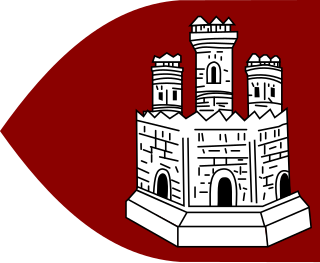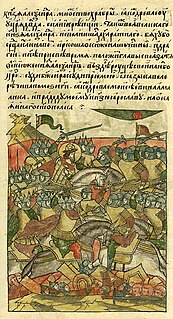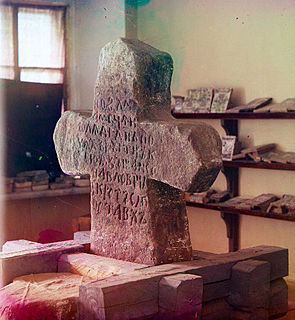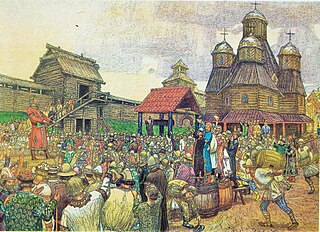 W
WThe Novgorod Republic was a medieval East Slavic state from the 12th to 15th centuries, stretching from the Gulf of Finland in the west to the northern Ural Mountains in the east, including the city of Novgorod and the Lake Ladoga regions of modern Russia. Citizens referred to their city-state as "His Majesty Lord Novgorod the Great", or more often as "Lord Novgorod the Great". The Republic prospered as the easternmost port of the Hanseatic League and its Slavic, Baltic and Finnic people were much influenced by the culture of the Viking-Varangians and Byzantine people.
 W
WThe administrative division of Novgorod Republic is not definitely known; the country was divided into several tysyachas and volosts. The city of Novgorod with its vicinity, as well as a few other towns were not part of any of those. Pskov achieved an autonomy from Novgorod in the 13th century; its independence was confirmed by the Treaty of Bolotovo in 1348. After the fall of the republic, Novgorod Land, as part of Russia, consisted of 5 pyatinas that were further divided into uyezds and pogosts. This division was replaced only in the beginning of 18th century when Peter I introduced guberniyas.
 W
WBirch bark manuscripts are documents written on pieces of the inner layer of birch bark, which was commonly used for writing before the advent of mass production of paper. Evidence of birch bark for writing goes back many centuries and in various cultures.
 W
WBjarmaland was a territory mentioned in Norse sagas since the Viking Age and in geographical accounts until the 16th century. The term is usually seen to have referred to the southern shores of the White Sea and the basin of the Northern Dvina River as well as, presumably, some of the surrounding areas. Today, those territories comprise a part of the Arkhangelsk Oblast of Russia, as well as the Kola Peninsula.
 W
WThe Cathedral of St. Sophia in Veliky Novgorod is the cathedral church of the Archbishop of Novgorod and the mother church of the Novgorodian Eparchy.
 W
WThe Finnish–Novgorodian wars were a series of conflicts between Finnic tribes in eastern Fennoscandia and the Republic of Novgorod from the 11th or 12th century to the early 13th century.
 W
WKhutyn Monastery of Saviour's Transfiguration and of St. Varlaam is an Orthodox monastery situated on the right bank of the Volkhov River some 10 km north northeast of Novgorod, in the village of Khutyn. It used to be one of the main Christian shrines of the medieval Novgorod Republic.
 W
WКontsy were the five boroughs into which medieval Veliky Novgorod was divided. They were based on the three original settlements that combined to form the city toward the end of the tenth century: the Nerev End, the Liudin ("People's") End, and the Slavno End; two later additions - the Plotnitskii ("Carpenters'") End and Zagorodskii End formed in 1168 and the 1260s respectively.
 W
WThe Legend of the White Cowl is a Russian Orthodox story first recorded by the monk Philotheus of Pskov in 1510. It tells of the passage of a religious relic of great significance through great danger from Rome to Constantinople and finally to Moscow, at a time that many Russians believed the pre-eminent Christian Church in the world to be transferred in Moscow.
 W
WThe Livonian campaign against Rus' was a military campaign that lasted from 1240 to 1242, and was carried out by the Teutonic Knights of the Livonian Order with the aim to conquer the lands of Pskov and Novgorod and convert them to Catholicism.
 W
WThe Novgorod Codex is the oldest book of the Rus’, unearthed on July 13, 2000 in Novgorod. It is a palimpsest consisting of three bound wooden tablets containing four pages filled with wax, on which its former owner wrote down dozens, probably hundreds of texts during two or three decades, each time wiping out the preceding text.
 W
WNovgorod Land was one of the largest historical territorial–state formations in Russia, covering its northwest and north. Novgorod Land, centered in Veliky Novgorod, was the cradle of Old Russian statehood under the rule of the Rurikovich dynasty and one of the most important princely thrones of the era of Kievan Rus'. During the collapse of Kievan Rus' and in subsequent centuries, Novgorod Land developed as an autonomous Russian state with republican forms of government under the suzerainty of the great princes of Vladimir. During the period of greatest development, it reached the North to the White Sea, and in the east it spread beyond the Ural Mountains. It had extensive trade relations within the framework of the Hanseatic League. In the 15th century, in the course of the grand–princely policy of "gathering Russian lands", Veliky Novgorod, with the surrounding lands, was completely annexed to the centralized Russian state. Novgorod Land existed as an administrative unit until 1708.
 W
WAccording to the traditional scholarship, the veche was the highest legislative and judicial authority in Veliky Novgorod until 1478, when the Novgorod Republic was brought under the direct control of the Grand Duke of Moscow, Ivan III.
 W
WRus' Chronicles or Rus' Letopisi are the main type of Old Rus' historical literature. Composed from 11th to 18th centuries the Chronicles are one of the leading genres Rus' literature and among the most extensive monuments to it.
 W
WThe Ostromir Gospels is the oldest dated East Slavic book.. The Ostromir Gospels was created by deacon Gregory for his patron, Posadnik Ostromir of Novgorod, in 1056 or 1057, probably as a gift for a monastery.
 W
WPosadnik (Cyrillic: посадник, was the mayor in some East Slavic cities or towns. Most notably, the posadnik was the mayor of Novgorod and Pskov. The term comes from the Old Church Slavic "posaditi," meaning to put or place; they were so-called because the prince in Kiev originally placed them in the city to rule on his behalf. Beginning in the 12th century, they were elected locally.
 W
WGreat Perm, or simply Perm, Latinised Permiae, was a medieval Komi state in what is now the Perm Krai of the Russian Federation. Cherdyn is said to have been its capital.
 W
WSadko is an opera in seven scenes by Nikolai Rimsky-Korsakov. The libretto was written by the composer, with assistance from Vladimir Belsky, Vladimir Stasov, and others. Rimsky-Korsakov was first inspired by the bylina of Sadko in 1867, when he completed a tone poem on the subject, his Op. 5. After finishing his second revision of this work in 1891, he decided to turn it into a dramatic work.
 W
WStaraya Ladoga ; Finnish: Vanha-Laatokka) is a rural locality in Volkhovsky District of Leningrad Oblast, Russia, located on the Volkhov River near Lake Ladoga, 8 kilometers (5.0 mi) north of the town of Volkhov, the administrative center of the district.
 W
WStaraya Russa is a town in Novgorod Oblast, Russia, located on the Polist River, 99 kilometers (62 mi) south of Veliky Novgorod, the administrative center of the oblast. Its population has steadily decreased over the past years, going from 41,538 recorded in the 1989 Census to 35,511 in the 2002 Census to 31,809 in the 2010 Census.
 W
WSterzh Cross is a stone cross formerly situated on the bank of the Sterzh Lake. It is now exhibited in the Tver History Museum, where it has been for over a century. Its height is 167 cm.
 W
WThe Strigolniki were followers of the first Russian heretical sect of the middle of the 14th and first half of the 15th century, established in Pskov and later in Novgorod and Tver.
 W
WThe Ushkuyniks, also Ushkuiniks or Russian pirates were free and democratic people from early Rus' state which originated in northern regions of Russia, medieval Novgorod, composed of Slavic people like the Ilmen Slavs or Novgorod Slovenes, Finno-Ugrics and Vikings who supposedly led the Viking-like life of fighting, killing, and robbery. The Ushkuyniks were widespread in large parts of the Russian north and sailed on the arctic ocean. The origin of the term Ushkuyniks is unknown. Most likely the word "ushkuy" derives from the Oskuya River in Russia. Most likely the term is also connected to the Russian word for tight or narrow, узко (usko), узкий, plural: узкие (uzkiye). Furthermore medieval Finnic type of flat-bottom ships are called uisk. In Eastern Slavic languages word "Uzh" (уж) translates natrix, and it was common for Norsemen to sail on narrow longships called "drakkar", which roughly translates as "serpent" from Old Norse. This translation of information shows a cultural connection between Northern Europeans. These ships could be easily transported over portages between watersheds, is also considered as the namesake.
 W
WVeche was a popular assembly in medieval Slavic countries.
 W
WVolokolamsk is a town and the administrative center of Volokolamsky District in Moscow Oblast, Russia, located on the Gorodenka River, not far from its confluence with the Lama River, 129 kilometers (80 mi) northwest of Moscow. Population: 23,433 (2010 Census); 16,656 (2002 Census); 18,226 (1989 Census).
 W
WYaroslav's Court was the princely compound in the city of Novgorod the Great. Today it is roughly the area around the Trade Mart, the St. Nicholas Cathedral, the Church of St. Procopius, and the Church of the Myrrh-bearing Women. The Trade Mart renovated and heavily modified in the sixteenth and seventeenth centuries, is all that is left of the princely palace itself. The prince also had a compound called the Riurik's Court south of the marketside of the city.